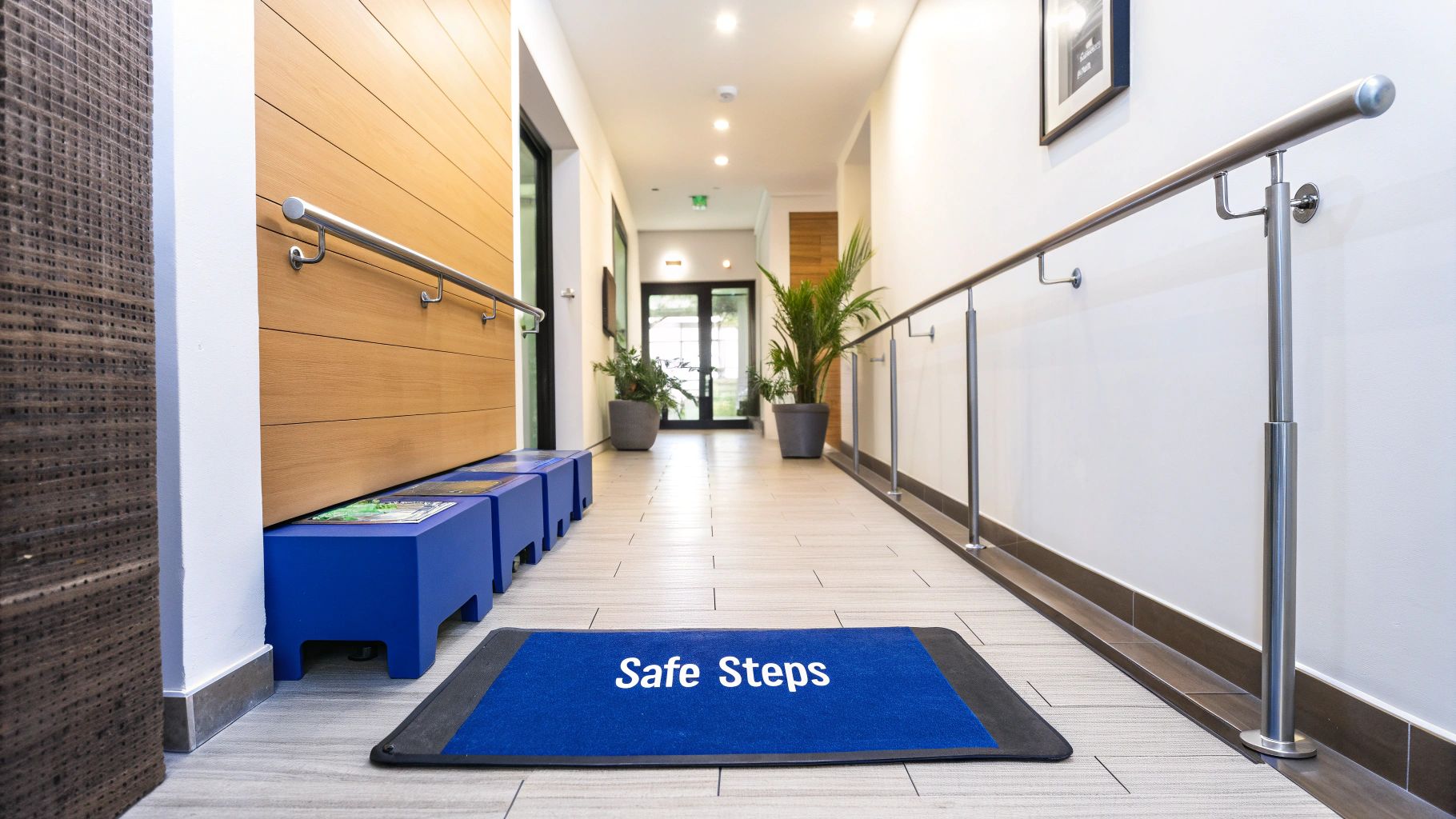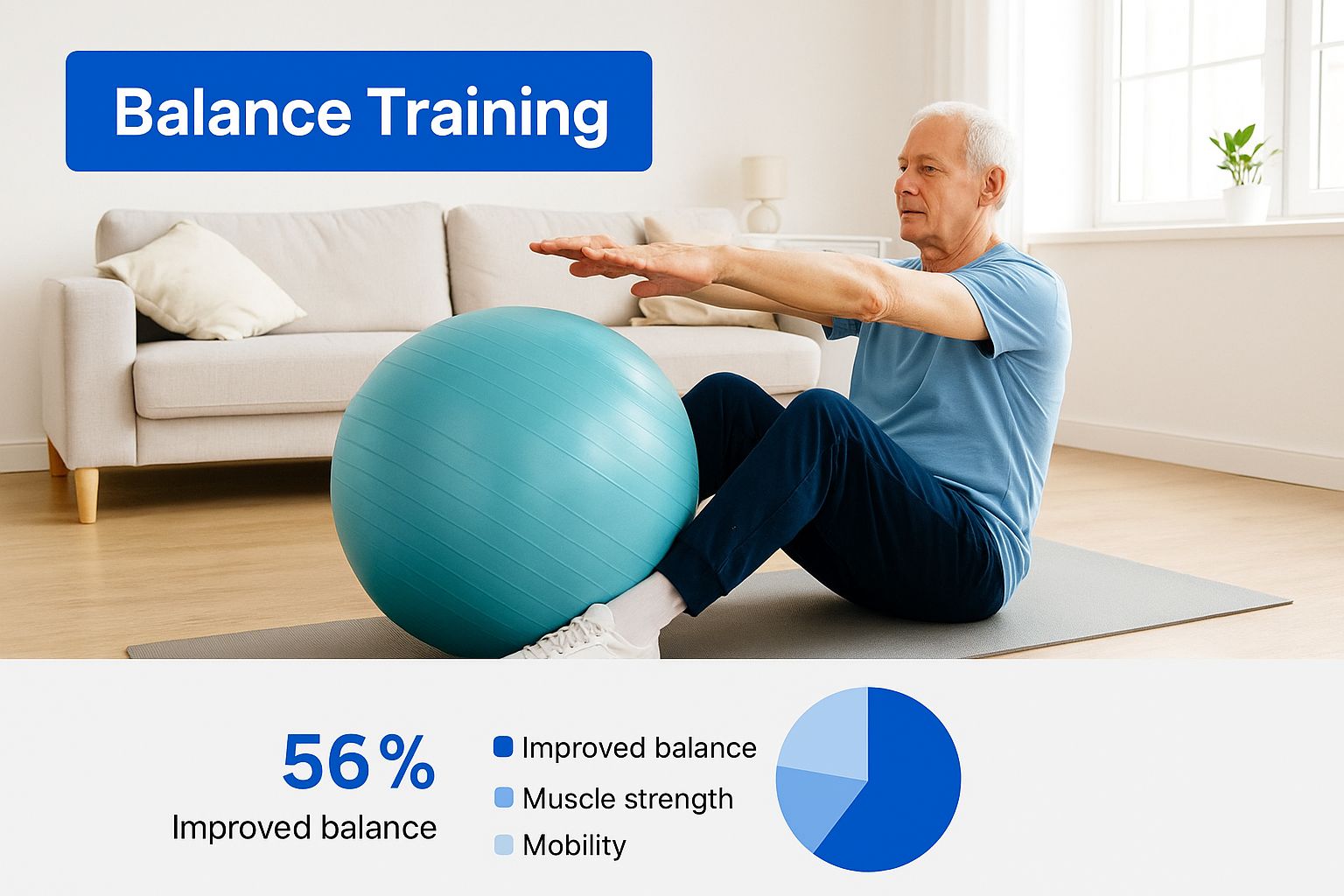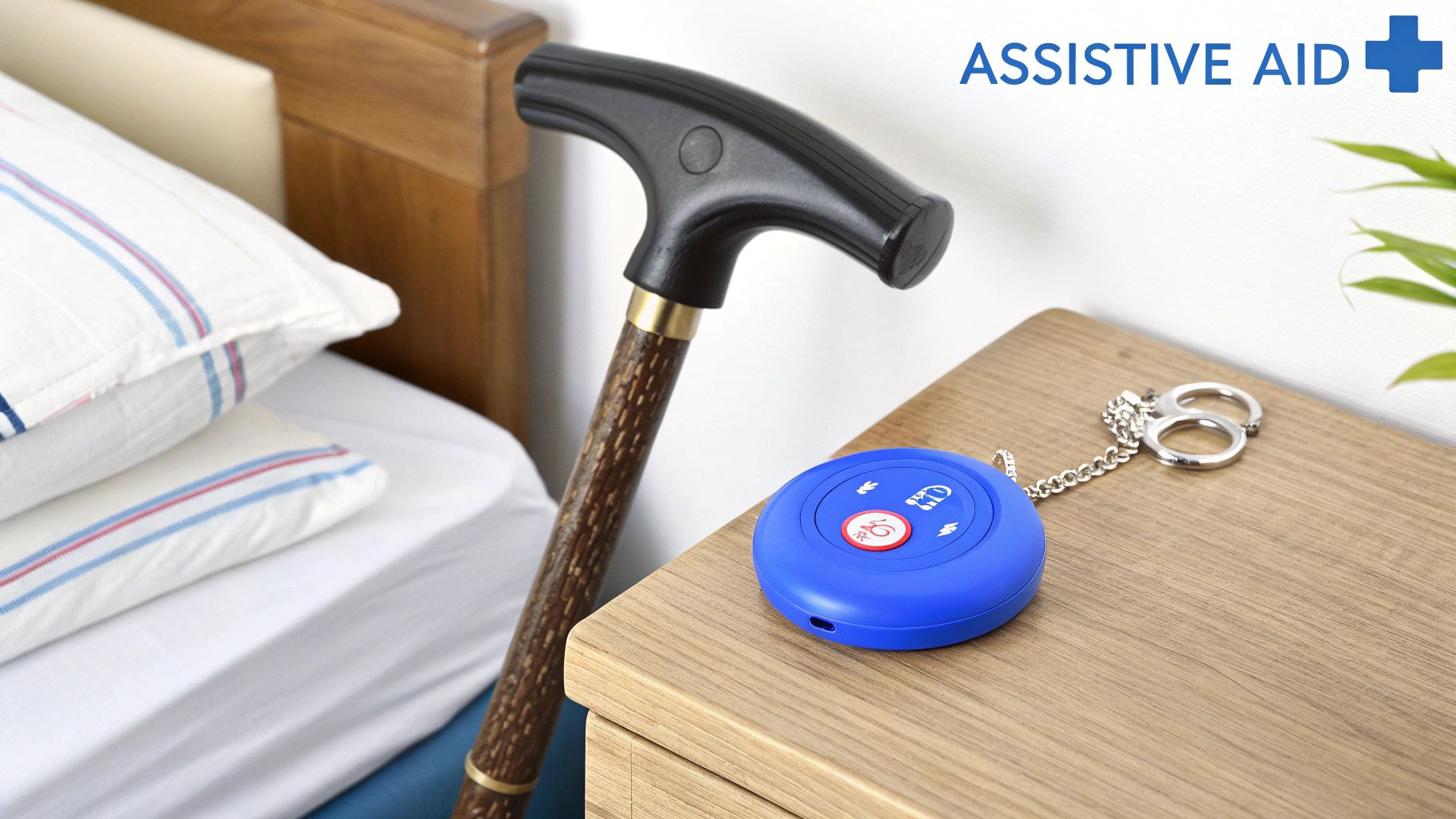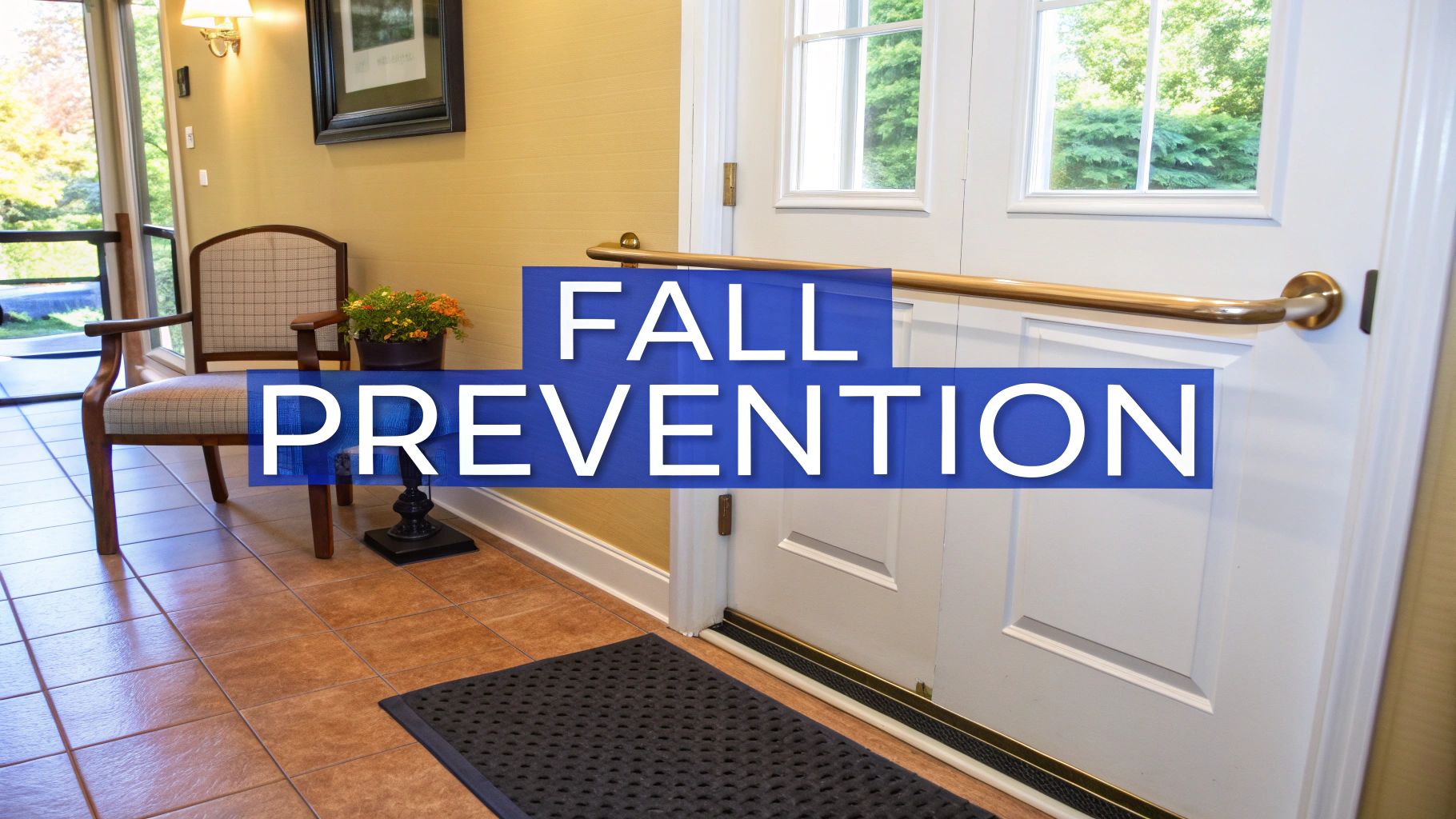It’s easy to think of fall prevention as just a safety checklist—installing grab bars, clearing clutter. But that’s only half the story. Taking proactive steps to prevent falls is really about protecting a senior’s independence, confidence, and ability to enjoy their life on their own terms.
When we address these risks before an accident happens, we’re empowering our loved ones to continue living the life they cherish, in the home they love.
Why Fall Prevention Is About More Than Just Safety
The thought of a parent or older loved one falling is terrifying. We immediately picture the physical aftermath: a broken bone, a trip to the hospital, a long recovery. While those are very real concerns, the true impact of a fall often creates a ripple effect that touches every part of a senior's life.
This isn’t about adding restrictions; it's about opening up possibilities. It’s about making sure Mom can still tend to her garden without worrying, or that Dad feels steady enough to walk to the mailbox and back. It's about turning their home back into a place of comfort, not anxiety.
The Hidden Costs of a Single Fall
A fall is rarely just a single event. For so many older adults, it marks a turning point that can trigger a deep-seated fear of falling. This fear is a powerful and destructive force. An individual who was once active and social might start avoiding stairs, skipping family get-togethers, or even limiting their movement inside the house.
This self-imposed isolation leads to less physical activity. Muscles get weaker, and balance starts to decline, which, in a cruel twist, actually increases the risk of another fall. It’s a vicious cycle that can quickly lead to loneliness and a devastating loss of independence.
The real goal of fall prevention isn't to limit life—it's to enable it. It's about taking proactive, empowering steps so a senior can continue to live a full, engaged, and independent life in the comfort of their own home.
Understanding the Widespread Impact
Many families don't realize just how common falls are. The numbers are sobering and show just how significant this issue is for older adults worldwide.
The table below provides a quick look at the statistics and their real-world consequences, highlighting why proactive prevention is so critical.
Quick Look at Fall Risks and Their True Impact
| Statistic/Factor | Key Data Point | Implication |
|---|---|---|
| Annual Fall Rate | About 28-35% of people aged 65+ fall each year. | This is a common, not rare, event. Nearly 1 in 3 seniors will experience a fall annually. |
| Increased Age Risk | The rate jumps to 32-42% for those over 70. | As your loved one ages, their risk naturally increases, making vigilance even more important. |
| Fear of Falling | A major consequence, even after a minor fall with no injury. | This fear can lead to decreased activity, muscle weakness, and social isolation, increasing future fall risk. |
| Hospitalization | Falls are a leading cause of injury-related hospital admissions for seniors. | A fall often results in complex medical needs and a difficult, lengthy recovery period. |
| Loss of Independence | A single fall can be the event that leads to needing assisted living. | Protecting against falls is a direct way to help a senior maintain their independence at home. |
These aren't just numbers on a page; they represent real people and real families whose lives are turned upside down.
Think about an 80-year-old woman who loves to cook. After a small trip in the kitchen while reaching for a high shelf, she becomes nervous. She stops trying new recipes and sticks to simple meals that don't require much movement. She loses a daily source of joy and creativity—not because of the fall itself, but because of the fear it left behind.
This is exactly why fall prevention for elderly at home is so vital. It tackles these fears head-on by creating an environment where seniors feel secure and confident. For more details on the global scope of this issue, you can explore additional data on this topic. It’s all about making their home a sanctuary again, not a source of worry.
Understanding Personal Fall Risk Factors

Truly effective fall prevention for elderly at home goes way beyond just clearing clutter off the floor. It starts with a closer look at the individual. Each person has a unique blend of health, history, and habits that creates their specific risk profile. Getting a handle on these personal factors is the most powerful first step you can take.
This isn't about dwelling on problems. Instead, it’s about pinpointing areas where a bit of support or a small adjustment can make a world of difference for their safety and confidence. When you know what the vulnerabilities are, you can start to address them before a fall ever happens.
Health Conditions That Affect Stability
Certain chronic health conditions are well-known culprits when it comes to throwing off a person's stability. They often sneak up slowly, so their impact on balance and strength might not be immediately obvious.
- Arthritis: When joints in the hips, knees, or feet are stiff and painful, it can make walking feel unsteady. A sudden twinge of pain is sometimes all it takes to cause a loss of footing.
- Diabetes: Nerve damage in the feet, or neuropathy, is a common complication that causes numbness. This makes it hard to properly feel the ground. On top of that, swings in blood sugar can trigger dizziness or weakness.
- Heart Conditions and Low Blood Pressure: Issues like postural hypotension—a sharp drop in blood pressure when standing up—can cause sudden lightheadedness, leading to a much higher risk of fainting or falling.
- Neurological Conditions: Conditions such as Parkinson's disease, a previous stroke, or multiple sclerosis directly impact balance, gait, and muscle control. This makes stable movement a daily challenge.
If your loved one is managing any of these conditions, it's so important to talk specifically about fall risk with their doctor. Simply asking how their condition affects balance can open the door to practical, targeted advice.
The Role of Medication Management
One of the most common—and most overlooked—risk factors is medication. While prescriptions are often necessary, many come with side effects that can significantly increase the odds of a fall.
A complete medication review with a doctor or pharmacist is a non-negotiable part of any fall prevention plan. This is especially true for anyone taking four or more medications. This situation, known as polypharmacy, is a major red flag for elevated fall risk.
Think about the side effects of some common types of drugs:
- Sedatives and Antidepressants: These can cause drowsiness, fogginess, and slower reaction times.
- Blood Pressure Medications: A common side effect is dizziness or feeling lightheaded, especially right after standing up.
- Pain Relievers: Opioids and even some over-the-counter options can impact a person's alertness and balance.
- Diuretics (Water Pills): These can lead to frequent, urgent bathroom trips, which often means rushing and increasing the chance of a misstep.
A "brown bag review" is a fantastic tool. This is where you gather every single medication—prescriptions, over-the-counter drugs, and even supplements—and take them all to a pharmacist or doctor. It's one of the best ways to spot risky interactions and side effects.
The goal isn't to stop necessary medications. It's about being aware of their effects and working with a healthcare professional to see if different doses or alternative drugs might be safer options.
Sensory Changes and Their Impact
Our senses are our body's internal GPS. As we age, changes to this system can throw it off course. When we can't see or feel our surroundings clearly, the risk of a misstep skyrockets.
Vision impairment is a perfect example. Things like cataracts, glaucoma, or simply an old glasses prescription can make it tough to see obstacles, judge steps, or get around in low light. Regular eye exams—at least once a year—are absolutely essential. You can discover practical caregiver strategies that help manage these kinds of daily challenges.
Another key system is the vestibular system in the inner ear, which controls our sense of balance. Age-related decline or conditions like vertigo can create a constant feeling of being dizzy or unsteady, making every step feel risky.
With the global population of people over 60 expected to hit 1.2 billion by 2025—a twofold increase from 2000—this has become a major public health focus. In response, international health organizations have created guidelines that stress the importance of screening for these personal risks. The first step in any effective plan is always addressing the individual.
Creating a Safer Home Environment, Room by Room
While personal health is a big piece of the fall prevention puzzle, the home itself plays an just as critical a role. The great news is that making a home safer doesn’t mean it has to feel like a hospital. In my experience, the most effective strategies involve thoughtful, practical changes that blend right in.
This is all about creating clear, safe paths for movement and making daily activities less of a risky chore. Let's walk through the home, room by room, to pinpoint the high-impact adjustments that protect independence while keeping that comforting feeling of home.
The Bathroom: The Highest-Risk Zone
If there's one room to focus on first, it’s the bathroom. It’s a perfect storm of hard surfaces, water, and tricky movements like stepping over a tub wall. This is where the risk of a serious fall skyrockets.
Here are the non-negotiables:
- Install Grab Bars Correctly: Forget the suction-cup models you see in stores—they’re unreliable. You need professionally installed, screw-in grab bars placed in key spots: next to the toilet, inside the shower, and just outside the shower door for stable entry and exit.
- Upgrade the Shower: A zero-threshold, walk-in shower is the gold standard. If a remodel isn't feasible, a sturdy shower chair or a transfer bench is essential. This allows someone to sit while bathing, which dramatically reduces the chance of a slip.
- Secure the Floor: A high-quality, non-slip bath mat with a solid rubber backing is a must-have, both inside and outside the tub. Look for one that's machine washable to keep it clean and effective.
- Improve the Lighting: Many bathrooms are surprisingly dim. Adding a bright night light that's easy to find in the dark can make a world of difference for those middle-of-the-night trips.
Think of these not as clunky additions, but as tools of empowerment. The stability from a single, well-placed grab bar can be the difference between a safe, independent shower and a life-altering fall.
Living Areas and Bedrooms: Promoting Free Movement
These are the spaces where we live and relax, so they need to be safe and easy to get around in. The main goal here is simple: create unobstructed, well-lit pathways from one part of the house to another.
Clutter is an obvious hazard, but the sneakiest culprits are often electrical cords. Tuck them safely behind furniture or use cord covers to run them neatly along baseboards. It’s a five-minute fix that removes a major tripping risk. Then, take a hard look at the furniture layout. Is there a clear, wide path from the bed to the bathroom? From the favorite recliner to the kitchen?
A simple rule of thumb: An ideal walkway should be at least 36 inches wide. This gives enough room to move comfortably, even with a walker or cane, without having to shuffle or turn sideways.
A few other high-impact changes for these spaces include:
- Ditch the Throw Rugs: They look nice, but small area rugs are one of the most common causes of falls. If you can't part with them, secure every edge firmly with double-sided rug tape.
- Check Chair and Bed Height: Is the couch too low and a struggle to get out of? A firm cushion or furniture risers can make a huge difference. The bed should be at a height where feet can rest flat on the floor when sitting on the edge.
- Light the Way: Place lamps where they're easy to reach from a sitting position. Consider swapping small toggle light switches for larger, rocker-style ones that are easier for anyone to use. You can also explore our visual guide on home setup for more ideas.

Making the living area safe for movement also creates the perfect space to do balance-building exercises, which further strengthens the body against falls.
The Kitchen: Optimizing for Easy Access
The kitchen has its own unique challenges, with all the reaching, bending, and carrying that happens there. The key is to make everyday tasks as effortless as possible to minimize the need for risky movements.
If you do one thing in the kitchen, reorganize the storage. Move the items you use every day—plates, glasses, coffee mugs, favorite pans—out of high cabinets and low drawers. Place them on the countertop or on open shelves between waist and shoulder height. This simple shift practically eliminates the need for a step stool, which is a notoriously wobbly and dangerous piece of equipment for anyone.
The statistics on falls are staggering. In the U.S., falls among older adults are a genuine public health crisis. About 14 million Americans aged 65 and older fall each year. These incidents are the top cause of injuries, both fatal and non-fatal, for this group, resulting in 38,000 deaths and 3 million ER visits in 2021 alone. The financial toll is just as massive, with treatment costs expected to exceed $101 billion by 2030.
By making these practical, room-by-room changes, you’re not just tidying up—you’re actively creating an environment that fosters safety and independence, directly combating these alarming statistics.
High-Impact Home Modifications by Room
To make this easier, I've put together a prioritized checklist. Focus on the most critical changes in the highest-risk rooms first to get the biggest safety boost for your effort.
| Room | Priority Modification | Why It's Important | Estimated Cost/Effort |
|---|---|---|---|
| Bathroom | Professionally install grab bars | Provides crucial support for getting on/off the toilet and in/out of the shower. | Moderate / Professional install recommended |
| Bathroom | Use a non-slip bath mat & shower chair | Prevents slips on wet surfaces and reduces fatigue during bathing. | Low / DIY |
| Living Room | Remove throw rugs & secure cords | Eliminates the two most common tripping hazards in living spaces. | Low / DIY |
| Bedroom | Ensure a clear, lit path to the bathroom | Makes nighttime trips to the bathroom significantly safer. | Low / DIY |
| Kitchen | Relocate frequently used items | Puts essential items within easy reach, avoiding risky stretching or bending. | Low / DIY |
| Stairways | Install sturdy handrails on both sides | Offers constant support when navigating stairs, a high-risk area. | Moderate / Professional install recommended |
Tackling even a few of these modifications can dramatically lower the risk of a fall and provide priceless peace of mind for everyone. It's about making a home work for the person living in it, not against them.
Building Strength and Balance with Simple Exercises
Making your home safer is a fantastic first step, but let’s talk about one of the most powerful tools in your fall prevention toolkit: building up your body's own defense system. When your leg muscles are stronger, getting up from a chair is less of a strain. When your balance is sharper, a little stumble doesn’t have to turn into a serious fall.
You don't need a fancy gym membership or complicated equipment. In fact, some of the most effective exercises can be done right in your living room, using nothing more than a solid chair for support. The real secret is consistency and focusing on movements that make everyday life easier and safer.
Of course, before starting any new fitness routine, it’s always smart to have a quick chat with a doctor. They can give you the green light and offer advice tailored to your specific health needs.
Foundational Strength: The Chair Stand
Think about it—how many times a day do you get up and sit down? From the dining table, the sofa, even the car. Each one of those simple movements relies on leg strength. The chair stand is an incredibly straightforward exercise that directly builds the exact muscles you need for this daily activity.
Here’s how you can do it safely:
- Find a sturdy chair. A solid, armless dining chair is perfect. Steer clear of soft recliners or anything with wheels. For extra security, place it against a wall.
- Sit near the edge. Scoot forward so you’re on the front half of the seat. Your feet should be flat on the floor, about shoulder-width apart. Keep your back straight and cross your arms over your chest.
- Stand up slowly. Lean forward just a bit from your hips and push through your heels to rise to a full standing position. The goal is to avoid using your hands to push off.
- Sit back down with control. Slowly reverse the motion. Bend your knees and lower yourself back onto the chair—don’t just plop down. Controlling the movement on the way down is just as important as standing up.
Try to do a set of 8 to 12 repetitions. If that feels like too much at first, just do what you can. The key is to start somewhere and gradually build up. This single exercise will make a noticeable difference in your ability to get out of a car or stand up from the toilet with confidence.
Sharpening Your Balance with Simple Movements
Good balance is one of those things we take for granted until it starts to fade. It’s a complex dance between our muscles, our inner ear, and what our eyes see. The great news? You can absolutely train your balance and make it better with a little practice.
Always do these exercises near a kitchen counter or a heavy piece of furniture you can grab for support.
- Heel-to-Toe Walk: This is just like walking on a balance beam. Place the heel of one foot directly in front of the toes of the other. Take 10-15 steps forward, focusing your gaze on a fixed spot across the room.
- Single-Leg Stance: Stand behind a sturdy chair, holding on for support. Lift one foot off the floor and try to hold the position for 10-15 seconds. Then, switch to the other leg. As you feel more stable, challenge yourself by holding on with just one hand, then maybe one finger, and eventually, not at all.
You might feel a bit wobbly when you first try these, and that’s perfectly okay. That "wobble" is your body’s balance system firing up and relearning how to keep you steady. It’s a sign that you’re doing it right.
The Gentle Power of Tai Chi
If you're looking for a more structured approach that beautifully combines strength, balance, and a sense of calm, Tai Chi is a fantastic choice. This ancient practice uses slow, flowing movements that are incredibly gentle on the joints but remarkably effective for fall prevention.
Countless studies back this up, showing that regular Tai Chi practice can dramatically reduce the rate of falls in older adults. It works by improving:
- Leg Strength: The slow, controlled poses build both endurance and power.
- Balance: Constantly shifting your weight from one foot to the other fine-tunes your stability.
- Flexibility: The graceful stretches help improve your overall range of motion.
Many local community centers and senior groups offer beginner Tai Chi classes designed specifically for older adults. It's a wonderful way to improve your physical stability while enjoying a social and calming activity. By weaving these simple but potent movements into your weekly routine, you’re not just exercising—you’re actively building a more resilient body and moving through your world with greater confidence.
Smart Lifestyle Changes and Assistive Tools
Beyond exercises and home modifications, some of the most powerful ways to prevent falls at home are through small, consistent lifestyle adjustments and knowing which tools can help. These aren't signs of weakness; they're smart, proactive choices that empower older adults to live with more confidence and independence.
It really comes down to being deliberate. The shoes you put on in the morning, staying hydrated, or using a cane for a walk in the park—these small decisions work together to create a powerful safety net against falls.
The Foundation Starts with Your Feet
We often don't think twice about what's on our feet, but the right footwear is a crucial first line of defense. Slippers, loose sandals, and even just walking around in socks are common habits that can dramatically increase the risk of a slip or a trip. Stability starts from the ground up.
Look for shoes that offer:
- A Secure Fit: The shoe should fit snugly without pinching, supporting the entire foot.
- Good Grip: Thin, non-slip soles made of rubber or a similar material will give you the best traction on different floors.
- Proper Support: A low, wide heel offers the most stability. It's best to avoid high heels, narrow bases, or shoes with worn-out treads.
Having a good pair of supportive indoor shoes is just as important as your outdoor ones. Simply swapping flimsy slippers for a dedicated pair of "house shoes" with a solid sole is an easy change that pays off big in safety.
Fueling Your Body for Stability
What we eat and drink has a direct, and often immediate, impact on our balance and alertness. Dehydration is a surprisingly common culprit behind dizziness and lightheadedness in older adults, both of which are major precursors to a fall.
At the same time, poor nutrition can lead to muscle weakness and fatigue. A balanced diet rich in protein, calcium, and Vitamin D is essential for maintaining strong muscles and bones. This isn't just about long-term health; it’s about giving your body the fuel it needs to stay steady and strong all day long.
Think of hydration and nutrition as your internal stability tools. A well-hydrated and well-nourished body is far less prone to the sudden spells of dizziness or weakness that can lead to a dangerous fall.
Choosing and Using Assistive Devices Correctly
Assistive devices like canes and walkers are incredible tools for maintaining independence, but only if they’re used correctly. I've seen many people resist using them because they see them as a symbol of frailty. In reality, they are symbols of intelligence—a smart way to continue enjoying your world safely.
Selecting the Right Device
The choice between a cane and a walker really depends on the individual's needs.
- Canes are best for someone who just needs a little extra support with balance or wants to take some pressure off a painful joint. A single-point cane is often enough, but a four-point (quad) cane offers a wider, more stable base.
- Walkers provide a much higher level of support. They're ideal for those with significant weakness or balance challenges. A standard walker offers maximum stability, while a rolling walker (or rollator) with wheels and brakes is easier for people who have trouble lifting.
Ensuring a Proper Fit
An improperly sized device can be more dangerous than having none at all. The fit is absolutely everything.
| Device | How to Measure for Correct Height |
|---|---|
| Cane | Standing straight with your arms relaxed at your sides, the top of the cane's handle should come to the crease of your wrist. |
| Walker | Standing inside the walker with your arms at your sides, the handgrips should be level with your wrists. |
When you use either device, your elbow should have a comfortable bend of about 15 to 20 degrees. A physical therapist is the best person to help fit a device and provide personalized training. They can make sure you know how to handle different terrains, turn safely, and sit or stand correctly.
For a helpful visual on caregiver support, take a look at our caregiver resources. Embracing these tools and habits is a huge step toward staying active and engaged in life.
Answering Your Questions About Fall Prevention

When you're trying to keep a loved one safe, it’s completely normal to have questions. You've learned about personal risks, home modifications, and exercises, but figuring out how to apply it all can feel like a huge task. Let's tackle some of the most common—and trickiest—concerns families face with some straightforward, actionable advice.
Our goal here is to help you move past that feeling of uncertainty and into confident action. By addressing these tough topics head-on, you can build a truly effective strategy for fall prevention for elderly at home and gain some much-needed peace of mind.
What If My Parent Refuses Help or Won't Use a Walker?
This is one of the most common and delicate situations we see. Resistance almost always comes from a place of pride and a very real fear of losing independence. The absolute key is to approach the conversation with empathy, not as an authority figure.
Try framing assistive devices not as a sign of weakness, but as a tool for empowerment. Think of it as a way for them to keep their independence, not lose it.
For instance, you might say, "Mom, I know how much you love your morning walks. Using this cane could give you the stability to keep doing that safely for years to come."
Here are a few communication tips that can really help:
- Focus on Their Goals: Connect the change to something they truly value, like staying in their own home or being able to attend their grandkids' events without worry.
- Start Small: Suggest using a cane just for longer walks or on days they feel a little tired, rather than insisting they use it all the time.
- Involve a Professional: Sometimes, the message sinks in better when it comes from a doctor or physical therapist. An expert can explain the medical benefits in a way that feels less personal and more practical.
Remember, the goal is collaboration, not control. Acknowledge their feelings and work together to find a solution that helps them feel both safe and in charge of their own life.
How Much Do Home Modifications Cost?
The cost of creating a safer home can vary dramatically, but you’ll be relieved to know it doesn't have to break the bank. In fact, many of the most impactful changes are low-cost or even free.
- Free or Low-Cost Changes: Getting rid of clutter, securing electrical cords, rearranging furniture for clearer pathways, and ditching throw rugs are all completely free. Adding non-slip tape to stairs or buying a high-quality bath mat costs very little.
- Moderate Investments: A sturdy shower chair or a transfer bench is a moderate expense that provides a massive safety return. The same goes for professionally installed grab bars—their value is immeasurable.
- Larger Projects: A major renovation like installing a walk-in shower is a significant investment. But when you compare it to the potential cost of a fall—both financially and emotionally—it's often a worthwhile consideration down the road.
Start with the highest-impact, lowest-cost modifications first. You can make a huge difference in home safety for under $100.
What Is the Most Important First Step to Take?
If you feel overwhelmed and just don't know where to begin, start with a simple conversation. The most crucial first step is to talk openly and honestly with your loved one about fall prevention. Sit down together and discuss their concerns, fears, and daily challenges.
From there, the next most important action is a medication review. We've mentioned it before, but it bears repeating: medications are a huge contributing factor to falls. Schedule an appointment with their primary care doctor or a pharmacist to go over every single prescription, over-the-counter drug, and supplement they take.
This one action can uncover and resolve hidden risks that no home modification can fix. It’s a simple, powerful step that truly sets the foundation for every other prevention effort.
Navigating the complexities of fall prevention can be a challenge, but you don't have to do it alone. For families in Mercer County, NJ Caregiving provides compassionate, professional in-home support to help your loved ones live safely and confidently.
Learn more about our personalized care services at https://njcaregiving.com.



